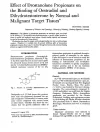I wonder if it increases e1 like EQ does
I don't believe so.
I actually don't remember what the mechanism is, but I've heard multiple people talk about what you're saying here. The main issue I often see is that people think there's some magic ratio to use it but it varies by individual.
There's a couple things at play here, presuming my aforementioned understanding is correct. The literature on this is relatively recent and not easy to parse in the sense that most of it is beyond my expertise. There is this paper:
Which identifies two metabolites of metenelone acetate that show aromatase inhibitory activity. They are compared to exemestane.
One presumes, but I can't definitively say that these metabolites would exist in humans. They used fungi in this paper. There is a 2019 study that used HPLC on human urine to identify 16 new metabolites that were previously undocumented. For one, I don't have access to that paper, and for two, the AI metabolites listed above are not named, they simply give the chemical structure, which makes it hard to search for.
I think it's reasonable to deduce, however that there is some AI activity in humans given our respective anecdotal experiences. As you pointed out, it varies by individual.
From my own personal experience, I could run test and primo 1:1 and keep e2 in range (while blasting) when I was closer to 20% body fat. Once I was down to 10% or under, I discovered that I had nearly crashed my e2 with 1:1. Currently, I'm at 2:1 around 9% bodyfat and still with low e2, but I fucked up and experimented with EQ for a minute and I'm waiting for that to clear my system.
I suspect that there are two primary variables then that affect the AI activity. The first would be the liver enzymes that metabolize metenelone. I'm not sure which allele that would be, but some folks are slow or fast metabolizers of various drugs based on how their genetics determine liver enzyme expression. The second would be the degree of adipose tissue which determines the expression of aromatase.


